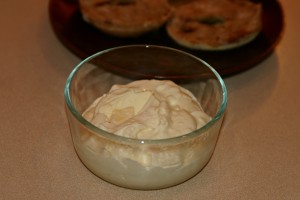My husband and I have been having a disagreement over spreadable butter. He doesn’t like the taste of butter (sometimes I wonder how I married him!) and he doesn’t like how hard it is to spread when it comes out of the refrigerator. I, on the other hand, love butter and have no problem waiting for the butter to soften or even popping it in the microwave for 10 seconds.
Because I love him, I have been buying that “butter” spread that comes in a plastic container. Granted it is the Earth Balance kind so it is a little better for you than some of the conventional versions. But I cringe every time I have to drop one of those plastic tubs into the recycling bin. I searched far and wide for a buttery spread that comes in glass with no luck.
And then it hit me. I can make my own butter spread! I searched the internet and came up with these recipes:
Basically, you just put a stick of butter and between 1/3 cup and 1/2 cup of oil (canola, olive or grapeseed) into a mixer and mix until soft and creamy. Some recipes say to use room temperature ingredients and others say to use chilled ingredients. Some recipes also add other ingredients such as water, salt and lecithin. I used the recipe from Tammy’s Recipes which also calls for the addition of water.
Here’s how I did it:
I used my Kitchenaid mixer to whip together two sticks of butter at room temperature, 1/2 cup of canola oil and 1/2 cup of water at room temperature. Once it was smooth and creamy, I took the final product and stored it in a glass Pyrex container in the refrigerator. It works pretty well, but is still a little hard to spread (although it melts pretty quickly when applied to warm bread). It doesn’t taste much different than butter and my husband seems to like it too.
Next time, I will definitely try the recipe from Average Betty and see how much of a difference it makes to use chilled ingredients and no water.
Why you should make your own spreadable butter:
- Whipping the butter and adding canola oil results in a product that has less saturated fat than regular butter. Adding water helps even more.
- Pre-made spreadable butter costs more money.
- Toxic ingredients in plastic can leach into foods. This is especially true for disposable plastics such as butter containers.
- You can be sure of what ingredients are in your butter spread.
- Plastic is bad for the environment, and all of those containers just end up sitting in landfills.

